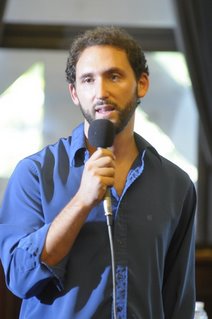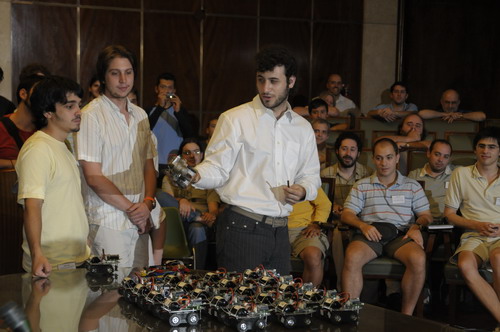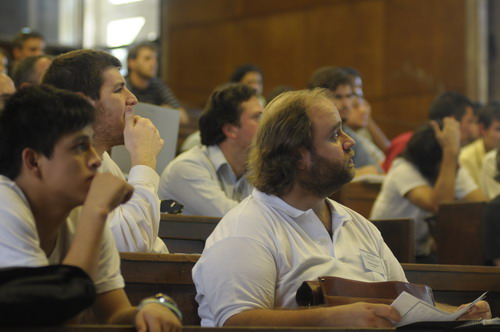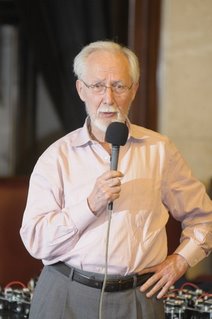Argentinean Symposium on Embedded Systems (SASE)
A few weeks ago, Ariel Lutenberg and his hard working collaborative put on an impressive event in Buenos Aires that attracted over 500 eager embedded engineers to learn about, discuss and develop with embedded systems; not bad for a first attempt!
The agenda included an excellent mbed workshop, involving programming mbed-based line following robots as part of an introduction to working with microcontrollers; you'll have to wait until part 2 where we'll have some details (and videos!) from Lucas and Joaquin, the workshop organisers.
Congratulations to Ariel and everyone involved for pulling off such a successful event! Let's hope this leads to SASE2011.
So in our first guest blog, here is Ariel with a great writeup of SASE2010:

Argentinean Symposium on Embedded Systems (SASE); a link between industry and academy
By Ariel Lutenberg, PhD. Professor, Buenos Aires University and SASE 2010 general manager
Between March 3th-5th of 2010, the Argentinean Symposium on Embedded Systems (SASE 2010, http://www.sase.com.ar) was held at the University of Buenos Aires. The event was sponsored by 32 universities, 10 agencies and institutions, and 13 companies (including ARM Ltd. and NXP Semiconductors Inc.). About 500 people from Argentina and other countries participated in the several activities that were organized: 35 tutorials, 6 plenary sessions, 5 workshops, a student project’s contest and a prize for new products proposals.
The tutorials covered several areas, ranging from “Microcontroller architectures and technologies” to FPGA basics and advanced applications, and including software oriented topics like “Embedded internet” or “Linux for embedded systems”, and interface technologies, such as USB, I2C, CAN and JTAG. There were also tutorials about hardware related topics, like “Li-Ion and Li-Polymer batteries technologies” and “How to design electronics for high quantities manufacturing”, and also more introductory level tutorials, like “Programming microcontrollers in C Language”. These wide offer attracted people from academia and industry, thus achieving one of SASE objectives that was to bring close this two sectors.
Another objective of the event was to promote the interest of young professionals and engineering students on embedded systems, and that was successfully achieve by means of two different activities.
1) The “mbed workshop”, that was oriented to people whose previous experience was only about programming 8 bit microcontrollers in Assembly language and the usage of C language for computer programs, and who after the nine hours workshop were not only able to program the 32-bit Cortex-M3 microcontroller of the mbed rapid prototyping kit in C language, but also used this platform to program the control algorithm of a line follower car that was provided to the participants and use these cars to participate in a race that was organized between more than 30 cars!

2) A student project’s contest, where thirteen high level design were presented, including an FPGA simulator for Nuclear plant processes, a Low power access method for IEEE 802.15.4, different FPGA softcores implementations, an adaptive audio equalizer, and several automotive robots.

Also, a goal of SASE was to spread the more recent advances and trends on embedded system technologies, and it was achieve by means of world class tutorials such as “Implementing Cortex A-8 technology in a FPGA”, by Steve Ravet from ARM, or “Twenty years of experience in designing complex embedded systems”, by Erio Schweickardt from INVAP, who covered the company experience in designing satellites, nuclear plants and radars.

The key note was the plenary session that closed the event, which was presented by Ramon Alonso, an eighty years old Argentinean that during the ’60s was assistant director of the MIT instrumentation lab team that designed for NASA the Apollo Guidance Computer, the heart of the Apollo series of spacecrafts, the missions that first took the man to the moon. Ramon presented an informal lecture where talked about the Apollo program and chat with the audience about the extremely interesting experience he got during those days, were the first modern computer was designed, using for the first time integrated circuits, and revolutionary solutions, as the introduction of the first ROM program, which was implemented using a ferromagnetic rope style memory.

For SASE 2011, we expect to offer even more tutorials and workshops, receive the sponsorship for even more companies, universities and institutions, and to account with more than 700 attendees from all Latin America, and hopefully from other continents, too.
Looking forward to see you all at SASE 2011,
Best regards,
Ariel Lutenberg.
For more information visit www.sase.com.ar or write an email to info@sase.com.ar
Details of the mbed workshop to come...
You need to log in to post a comment
